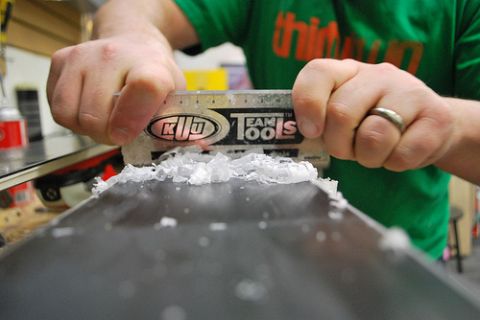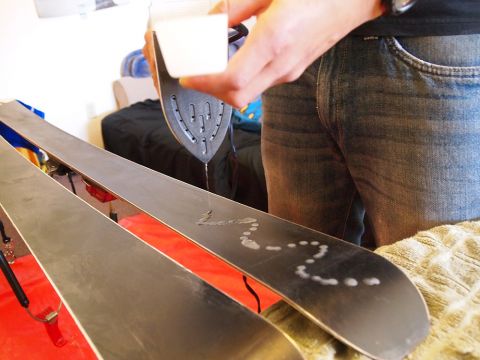Can waxing your skis be bad for your health?
A rather interesting story from Environmental Health News about the health implications of waxing your skis. While this does not apply to everyone out there it may be of interest to those it talks about who are most at risk:

Scientific research suggests that ski wax can expose users to perfluorochemicals (PFCs) that build up in their bodies and may carry potentially serious health risks, including cardiovascular disease, liver damage, hormone disruption and cancer.
Racers, in particular, covet waxes with high amounts of fluorinated compounds because they make skis go faster. But that extra speed could come at a cost, especially to thousands of junior ski racers and parents who may layer on highly fluorinated race wax week after week without knowing how to handle it safely.
Two new studies, conducted in Sweden and Norway and published in September, found that wax technicians working for World Cup ski race teams had very high levels of PFCs in their blood. Their median levels of one compound, perfluorooctanoic acid or PFOA, were up to 45 times higher than the general population’s. The second-highest compound was perfluorononanoic acid (PFNA), a common contaminant in wildlife that is now on the rise in people.
Adding to the concern, one of the studies suggests that the technicians may be manufacturing PFOA and PFNA in their own bodies, metabolizing it after breathing in a common industrial chemical, fluorotelomer alcohol (FTOH), that was found in high quantities in the workroom air. That process, known as biotransformation, has been demonstrated in animal studies, and lead author Helena Nilsson of Sweden’s Orebro University said her group’s research now reveals for the first time “direct evidence of human biotransformation.”
“This study is really important because it shows that this process is happening in humans,” she said. “We already knew that it happens in animals.”
In shops, chalets and slope-side tents from the Sierra Nevada and the Rockies in the American West to the European Alps and beyond, legions of skiers and snowboarders are waxing up their gear before a big race or just a fun day on the mountain. A base saturated with wax is the key to making cross country and downhill skis and snowboards glide fluidly over snow, the prerequisite for speed.
The technicians in the studies used hot irons to melt layers of wax onto racers’ skis, then ironed the waxed surface to make it adhere, and scraped it smooth. The process, often performed in small, stuffy cabins, produces clouds of fumes, dust and airborne wax particles, which the World Cup team waxers inhaled for approximately 30 hours a week during the November-to-March race season.
Little information is available on the chemical composition of ski waxes, because companies closely guard their formulas. Most race waxes contain water-repellant additives known as “fluoro”, but manufacturers do not reveal whether these include the potentially harmful perfluorinated chemicals turning up in human blood. When the researchers in Norway analyzed 11 different race waxes, however, they found PFCs in every one.
Costing as much as $100 a gram, high-fluoro waxes are too expensive for most recreational skiers and boarders. But the products are in big demand at competitions, including junior race events.

“With the fluoro, we all know it’s a little bit on the nasty side,” said Greg Whitehouse, who owns California Ski Company in Berkeley. “We prefer to not be around it.”
Because they do not break down naturally in the environment, PFCs are nearly indestructible. These chemicals are now found in wildlife and humans throughout the world. The U.S. Centers for Disease Control and Prevention, which tracks chemical exposures in several thousand Americans each year, has found “measurable levels of PFOA and several other PFCs in nearly every person examined,” said Jay Dempsey, the CDC’s health communications specialist.
The main sources of exposure for the general population appear to be from consumer products, drinking water and food, according to the CDC. One compound, former Scotchgard ingredient perfluorooctane sulfonate (PFOS), was phased out by 3M, its U.S. manufacturer, in 2000. U.S. industries also agreed in 2006 to begin phasing out PFOA, used in the manufacture of Teflon. But these pervasive substances continue to be found in variety of items, possibly as a manufacturing by-product.
In Sweden, the researchers followed eight technicians throughout the 2007-08 World Cup cross-country competitions, analyzing their blood and samples of the workroom air. In Norway, a research group led by Dag Ellingsen, of the Norwegian National Institute of Occupational Health, conducted similar analyses on 13 professional waxers during the 2008-09 World Cup season.
Both groups found high levels of PFOA and PFNA in the technicians’ blood. Both also found PFC levels rising with the number of years on the job, indicating that the compounds bioaccumulate in humans: piling up faster than the body can eliminate them.
“We cannot say how [the PFCs] will affect the waxers’ health later on,” said Nilsson, “but there are a number of biological alterations in relation to PFC exposure shown in animal studies.”
Research on the health effects of perfluorochemical exposure is still in the early stages, and most studies to date have focused on PFOA. The compound causes cancer in animal studies and the Environmental Protection Agency declared it “likely to be carcinogenic to humans.”
Epidemiological studies of people living near a West Virginia DuPont plant that manufactured PFOA have found elevated risks of a variety of health problems, including liver damage, birth defects, high cholesterol and excessive uric acid, which is linked to hypertension and strokes. One recent study of nearly 4,000 U.S. adults found an elevated rate of thyroid disease in those with the highest PFOA exposure. Animal tests also show that it may act as a hormone disruptor, mimicking estrogen. Much remains to be learned about this ubiquitous chemical.
While technicians in Norway and Sweden now work in specially designed, ventilated trucks, “most nations in ski competitions still have the traditional wax cabins with no or very poor ventilation,” Nilsson said.
For do-it-yourselfers, she advises: “Make sure that the room is ventilated. A [respirator] with a proper filter is also recommended.” She added, “There is no need to worry too much if one only intends to wax the occasional one or two pair."
Concerns are greatest for professionals like those in the studies, who waxed as many as 20 pairs of skis a day.
At most resorts and shops like California Ski Company, wax is applied in a ventilated area that limits exposure to the fumes, according to Whitehouse. But at competitions, high-fluoro race waxes are used in a largely unregulated environment, he said.
“What goes on inside the tent is sort of secret and voodooish,” Whitehouse said.
He added that events for youngsters may present a special risk. “The junior racers, the parents are there trying to tune their skis, do the best they can. And they probably don’t have much information on safety.”
The popular sports of junior ski and snowboard racing draw thousands of young competitors across the country. Most ski resorts have at least a few teams, with serious racing starting at about nine years old.
San Francisco Bay Area parent Erle Flad agreed that many of the parents at junior racing events don’t use the high-fluoro race wax correctly. “They’re all going crazy, scraping and brushing and overlaying their kids’ skis to make them as fast as possible.”
Flad, who has been going to junior races since his oldest child, now 23, was on the team, said he never sees parents using a respirator when applying wax. Still, he thinks PFC exposure is mainly a concern at big events like the World Cup, where several waxers work together in close quarters all day, rather than “Dads doing their kids’ skis generally the night before in the motel room, in the condo.”
PFC exposure is just one of the potential health risks facing professional ski waxers. Breathing high levels of airborne dust and particles, especially tiny nanoparticles, could lead to respiratory and cardiovascular disease, Nilsson added.
Interestingly, while both groups of researchers detected measurable levels of airborne PFCs in the workrooms, neither found enough to account for the high concentrations in the technicians’ blood. So Nilsson and colleagues tested the air samples for “precursor” chemicals known to break down into PFOA and PFNA. One stood out – 8:2 FTOH, a member of a volatile, highly reactive class of chemicals used as manufacturing agents. Concentrations were as much as 800 times greater than PFOA in the workroom air, leading researchers to conclude that biotransformation of the 8:2 FTOH fumes that waxers inhaled day after day was the main source of the PFOA and PFNA found in their blood.
“Knowing more about the metabolism is extremely important,” said Arnold Schecter, professor of environmental science at the University of Texas School of Public Health in Dallas, who was not associated with the project. “We need to know how this is getting into people.”
This biotransformation may become a growing source of PFC contamination in the future, as companies phase out use of PFOA and other perfluorinated chemicals, according to Nilsson. “Many industries have replaced their perfluorinated materials with telomer alcohols,” she said, “so the indirect human exposure to PFOA through telomer alcohols may very well increase.”
Ski workrooms are not the only place affected by PFCs in wax, said Nilsson. In an upcoming paper, she plans to publish data on PFC levels in snow.
“The wax definitely rubs off on the snow,” she said. She is also concerned about what happens to all the wax shavings at the end of the day. “Many kilos… end up on the floor in the cabins and are simply being put in the trash.”







